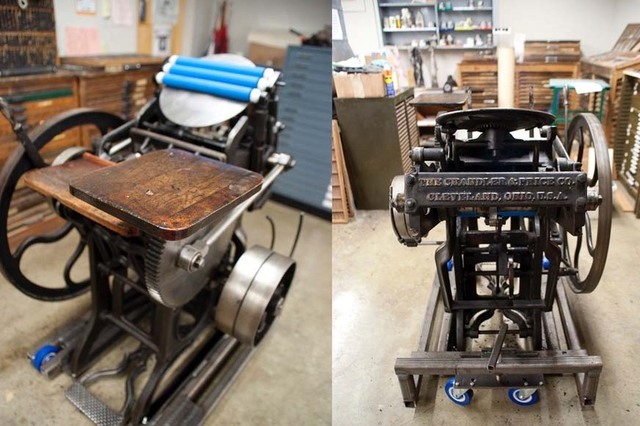Oct 5, 2020 In 2019, Rob Truszkowski accepted the Lieutenant Governor of Saskatchewan Heritage Award in the Intangible Cultural Heritage category for the University of Regina’s Letterpress Now initiative. Because our Awards have been cancelled due to COVID-19, we are catching up with past winners to see how their projects have evolved. Here, Rob answers a few of our questions about the project, and sheds some light on what it takes to revive a lost art, and why it is important to contextualize it in a contemporary context. Check out our YouTube video interview with Rob! Q: Since winning the 2019 Lieutenant Governor of Saskatchewan Heritage Award for Intangible Cultural Heritage, can you give us an update of this project? A: The nature of this project is a bit slow moving. To be honest, calling it a project, in a dictionary definition that involves a start and a stop point, doesn’t really apply. Right around the time I received this award, I got a text from Brooke, a former student who lives in Leader, SK. She was involved with the local arts council, and heard that there might be some strange old machinery, possibly for printing, in the back of a soon-to-be-demolished municipal building. When she had the chance to inspect it, sure enough, it was! She didn’t know exactly what kind of press it was, or if it would be salvageable, but she started sending me pictures and asking if I had any interest. (I did.) So two months later, a Vandercook no.5 Proof Press was lashed to the back of a tow-truck, and delivered to the University of Regina by friends of Brooke’s. The press was a mess… dirty, missing some parts, and clearly in need of a tune-up. We moved it into the Printmaking studio, and I tinkered with it, here and there, until the Winter break. I put in several days of fussy work, and just before Christmas, the old no.5 produced its first printed impression in at least 30 years! And that’s how this “project” goes. The universe offers up an “obsolete” machine, and someone in a truck puts it into a basement in Regina for me to save. Q: Can you describe how Letterpress Now started, and whether your motivations have changed since then? A: Despite my slightly self-congratulatory notion that I “save” old letterpress equipment, the heart of this endeavour has always been to make art. So much of what we consider to be letterpress, and indeed Printmaking as a whole, is obsolete… at least in terms of what this stuff and these processes were originally meant to be. The intention here was never to regain the precise skills and motivations of a letterpress printer from 100 years ago. Instead, I hope to recapture the spirit of the processes, and like any good artist, use that spirit to infuse the art that I make, and the art that my students make. And that is the distinction that always made this project about “intangible culture”, even though thousands of pounds of cast iron, lead, and ink are most certainly tangible! Q: How have students responded to the evolving letterpress area at the UofR? Does this old way of typesetting and printing inform their art practice in ways that a computer would not? A: Simply put, the students love it. Most 20 year olds have never even seen a typewriter, let alone considered the idea that hundreds or thousands of individual cast-lead letters could or would be assembled, by hand, to form the words on a page. Once they get over the initial shock of this fact, and possibly, overcome their trepidation at attempting to wrangle a 110 year old, foot-powered, 1500 lb printing press, to print a line of type, they are invariably smitten. The products of letterpress printing are real; physical, tangible, tactile. They look and feel and smell different that almost anything they have ever made themselves. To set type by hand, arrange it for printing, cut paper, mix ink, and print; these are very satisfying things, and even though this all feels very “old fashioned”, it exercises their brains in a very exciting, and contemporary way. Algorythmic problem-solving and critical thinking are so very important in their development as artists, and in fact as citizens of the world, and the letterpress excels at this like no computer can. Q: Will you continue to collect letterpress equipment? A: It’s a funny word; “collect”. I allude to this in an earlier answer, but this project is more about re-contextualizing than preserving. Yes, saving and preserving, tuning, cleaning, and restoring equipment to something that resembles a by-gone era is necessary to use the equipment to its fullest (and deeply enjoyable, frankly), but unless we can make art with it, it remains static; stuck in history. I suppose if I was being argumentative I would say that I will continue to “use” letterpress equipment. I don’t want a museum of things we used to use, I want a studio that is alive with the possibilities the equipment brings to it. But yes, I will continue to collect it, so if you have an old press and know someone with a truck, send me an email! Thank you to Rob Truszkowski for his insightful answers! Check out his Instagram page @professortruszkowski, and be sure to check back to our Blog for interviews with other past Award winners!Heritage Award Winners - Where Are They Now? Letterpress Now

